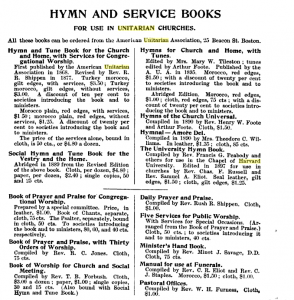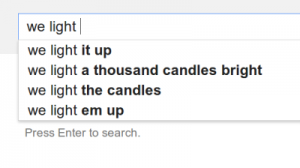The old joke that Unitarians believe in “one God at most” lives again in the paucity of resources we develop, projects we plan or visions we tolerate. Today, it’s “one idea at most” — and they’re rarely new.
One option at most for anything with Unitarian Universalism, even though our ancestors both on the Unitarian and Universalist sides were able to produce a variety of hymnals and different worship resources for differing churchmanships and congregation size, and with fewer people and at higher cost. We even had hymnals for church schools and social groups. Imagine what they would do with word processors and an on-demand book publisher like Lulu.com. The difference is will.
For years but particularly recently, I’ve been trying to figure out what would have been the trajectory of Unitarian (and) Universalist hymnody if it had not gone down a path lain down by Kenneth Patton, the influential editor of the “old blue” Hymns for the Celebration of Life. One practical reason is that such a hymnal might work better for Christian Unitarian Universalists.
And recently, I was in Massachusetts for friend, minister and blogger Victoria Weinstein’s installation, and spent a day researching at Harvard Divinity’s archives: I have and shall report out from those discoveries. But the library closed long before my train left Boston, so I went to the Harvard Co-Op to right a wrong. I had to buy the fourth edition (2007) of the Harvard University Hymn Book. I had opted against it the last time I was there.
When I came home, I started using old directories for background research, and look what I found. From the 1892 Year Book.
The Harvard University hymnal was once considered a suitable hymnal for Unitarian churches. “Of course it was,” I mused. 
And the more I look at it, I see the new edition would work in a liberal Christian church, including a Unitarian (or) Universalist one, the name notwithstanding. But here are a few (and hardly exhaustive) things I like about it, both serious and frivolous:
- It’s in very good taste and well typeset.
- It’s full of Unitarian standards like “Holy Spirit, Truth Divine” “Lord of All Being, Throned Afar” and “Life of Ages, Richly Poured”
- It has a good assortment of “canonical” spirituals and gospel songs, like “Shall We Gather At the River” “Lift Every Voice and Sing” and “There Is a Balm in Gilead.” “What Wondrous Love” keeps the Lamb.
- In good Hymns of the Spirit (1938) style, “God of Grace and God of Glory” is matched to Regent Square, not Cwm Rhondda, which we see fitly with “Guide Me, O Thou Great Jehovah.”
- It has good hymns newer than 1938. “Hope of the World, Thou Christ of Great Compassion” and “For the Fruit of All Creation” — ok: not many.
- Older hymns are altered more gently than say, in the UCC’s New Century Hymnal, while newer hymns are more gender-inclusive. (I’ve not made a close read of inclusive language for human beings, which I think is a more pressing claim for revision.)
- No need to tip in “Christ Jesus Lay in Death’s Strong Bands” (which always makes me cry) “O Sacred Head, Now Wounded” and “We Three Kings”
But
- There’s no responsive readings or service elements.
- No “Morning So Fair to See” “Eternal Ruler of the Ceaseless Round” or “O Life That Makest All Things New”
- I could do without the patriotic songs at the back.
- At $30, it isn’t cheap.





